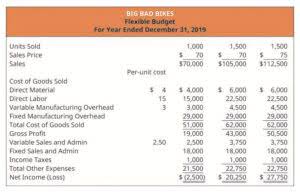
Similarly, insurance or brokerage companies don’t buy items wholesale for retail, so CCC doesn’t apply to them. The cash conversion cycle has a selective application to different industrial sectors based on the nature of business operations. The measure affects retailers like Walmart (WMT), Target (TGT), and Costco (COST), all of which buy and manage inventories and sell them to customers. Your company takes raw items on financing and has to pay their lenders / creditors in 30 days of period.
- The operating cycle formula in financial management helps determine the time a business takes to purchase inventory, then sell the inventory and then collect the cash from the sale of the inventory.
- Every business owner tries their best to reduce bad debt to maintain an easy flow of working capital.
- Consider offering discounts or attractive benefits to customers who pay early.
- Inventory days is the average number of days inventory held in the business and can be calculated using our inventory days calculator.
- A company’s cash conversion cycle broadly moves through three distinct stages and draws the following information from a company’s financial statements.
What Causes a Negative Cash Conversion Cycle?
- On average, it takes the company 97 days to purchase raw material, turn the inventory into marketable products, and sell it to customers.
- Therefore, while the operating cycle focuses solely on the time to turn inventory into cash, the cash cycle provides a fuller picture by factoring in how long the company can delay payments to suppliers.
- It equals the time taken in selling inventories (days inventories outstanding) plus the time taken in recovering cash from trade receivables (days sales outstanding).
- Next comes interpreting what these numbers mean for a company’s cash flow and overall financial health.
While both offer valuable insights, a cash cycle reveals a company’s ability to handle cash flow, whereas an operating cycle assesses the overall efficiency of its operations. Delving into the mechanics of business efficiency, calculating the operating cycle emerges as a pivotal task for financial managers aiming to optimize cash flow and enhance resource management. In this article, we will cover in detail about cash operating cycle in accounting. Before going further, let’s understand the overview of the cash operating cycle as well as the concept of working capital management. Length of a company’s operating cycle is an indicator of the company’s liquidity and asset-utilization. Generally, companies with longer operating cycles must require higher return on their sales to compensate for the higher opportunity cost of the funds blocked in inventories and receivables.
MSME Definition: MSME Meaning & Latest Classification with Turnover Limit in 2025
Such a company can improve its cycle either by implementing measures to quickly sell off its inventory or reduce the time needed to collect receivables. Calculating this cycle plays a significant role in assessing the efficiency of a business. On the other hand, a longer business operating cycle can strain cash flow, as money is tied up in inventory and receivables for an extended period. This can lead to cash shortages, making it challenging to pay bills, cover operating expenses, or seize new opportunities. Typically, a shorter operating cycle means a company converts inventory and receivables into cash more quickly. As a result, your business has enhanced liquidity, can meet its short-term obligations, and ledger account can invest in growth opportunities.

📆 Date: June 28-29, 2025🕛 Time: 8:30-11:30 AM EST📍 Venue: OnlineInstructor: Dheeraj Vaidya, CFA, FRM

It also covers the business stages where the company takes credit from suppliers and provides credit to clients. The cash conversion cycle calculator is a wise tool that can tell you how much time it takes for the company that you are AI in Accounting analyzing to complete its business operating cycle. In this article, we will cover the components of the cash conversion cycle formula, how to calculate it, the meaning of an increasing/decreasing and negative cash conversion cycle, and explore a real case example. For example, a bakery that takes 10 days to sell cakes and 5 days to collect payments has a 15-day operating cycle. In contrast, a furniture store with a 90-day cycle might struggle to pay suppliers if sales slow.
Accounts Receivable Management
The second is the ‘Accounts Receivable Period,’ which is how long it takes for a business to collect its dues following a credit sale. When we add up both these durations, we get the length of the operating cycle. One factor that is particularly important among these is working capital management. Working capital management refers to the strategy of a business to monitor the use of its current assets and current liabilities and managing it working capital to run the business operations smoothly. An effective working capital strategy can help the business increase its profitability and earnings through the efficient use of its resources.

Operating Cycle Formula

It’s a fundamental aspect of working operating cycle capital management and financial analysis, helping businesses to assess how quickly they can turn their operations into cash. The difference between the two formulas lies in NOC subtracting the accounts payable period. This is done because the NOC is only concerned with the time between paying for inventory to the cash collected from the sale of inventory. It’ll start from the time she purchases raw materials to create the apparel she sells.